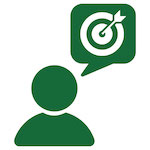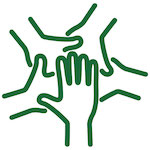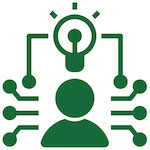Communicating Meaningfully
 Students engage in meaningful communication when they exchange ideas, facts, and perspectives with others. They are effective when they purposefully select and use strategies for communicating in response to context and audience.
Students engage in meaningful communication when they exchange ideas, facts, and perspectives with others. They are effective when they purposefully select and use strategies for communicating in response to context and audience.What this could look like across a program, for a learner, and in a single course:
| When I am learning | When I am ready to work with others | When I am prepared for my career | |
|---|---|---|---|
| What competency development might look like across a program... |
I choose how to communicate, and I think before I choose what to share and what not to share. I communicate using the conventions of my discipline (essay, lab report etc.) and cite appropriately. |
I build on and refine the ideas of others in a group. I engage in active listening as a process for informing and guiding communication within a team. |
I prioritize communicating with the beyond the university over communicating disciplinary understanding at them. I am purposeful in my communication, changing my word choice, methods, and medium for the community audience and purpose. |
| What this might look like for a student... | Beto considers what to say in class discussions to persuade others with a good argument and works hard to learn how a good literary essay is written | Beto facilitates a seminar discussion, asking helpful and insightful questions, and summarizing what he has understood, based on listening carefully to his peers’ comments to ensure he is adding significant ideas. | Beto changes his word choice and communications approach from an academic one with jargon of his discipline, to an accessible one in his work with community members so everyone can understand him. |
| What this might look like in a course... | In her Political Studies course, Dr. Ana Rodriguez effectively develops her students' competency in meaningful communication by incorporating a mix of reflective activities, group projects, and community engagement. She begins by having students maintain reflective journals where they analyze their communication choices in class discussions. Dr. Rodriguez facilitates group debates on current political issues, encouraging students to build on each other's ideas and engage in active listening. To prepare students for real-world communication, she assigns projects where they must present policy proposals to local community groups, adapting their language and approach to ensure accessibility and clarity. This comprehensive approach helps students like Beto learn to communicate thoughtfully and effectively, both within academic settings and with the broader community. | ||
Undergraduate Student Competency Program Rubrics – utilize or adapt this rubric for programs and courses.
Other ideas for developing this competency in the classroom:
- Reflective Activities: Assign reflective essays where students explain their thought process in choosing how to communicate their ideas in different scenarios. Use self-assessment tools where students evaluate their communication skills and set goals for improvement.
- Group Projects: Assign group projects where students must present their findings collaboratively, emphasizing the importance of building on each other's ideas. Organize peer feedback sessions where students critique each other’s communication styles and provide constructive feedback.
- Discipline-Specific Communication: Model the conventions of the discipline and how to communicate effectively within it. Provide examples of well-written essays, lab reports, and other discipline-specific formats. Have students practice writing and appropriately citing sources.
- Case Studies: Provide case studies that require students to analyze effective and ineffective communication strategies in various contexts.
- Communication Simulations: Use simulations where students must navigate complex communication scenarios, such as crisis communication or cross-cultural communication situations.
- Community-Focused Communication: Assign projects where students must communicate their disciplinary knowledge to a community audience, such as creating public service announcements, community presentations, or informational brochures.
- Community Workshops: Facilitate workshops where students present their academic knowledge in accessible formats to community members, receiving feedback on their clarity and effectiveness.
- Communication Portfolios: Have students create portfolios showcasing their communication skills, including written, oral, and digital examples.
Support
The Gwenna Moss Centre for Teaching & Learning
- connect with us to get one-to-one strategies to help learners develop this competency in your classroom. Email gmctl@usask.ca for information.
Career Services
- FUSION modules: Communication, Self-Managment, Metacognition, Digital Literacy, Collaboration, Adaptability
- Career Readiness Workshop: Self-Marketing
University Library
- Teaching Writing and Writing Help Guide - These guides offer strategies for improving students' writing skills, ensuring they can communicate their ideas effectively in academic and professional contexts.
- Graduate Writing Guide - provides advanced writing support for graduate students to help them articulate their research and ideas clearly.
- Learning Hub - helps instructors find academic skills resources, tutorials, and other learning support services for students. These resources can be integrated into courses as appropriate to support the development of USask graduate competencies
- Instructors can request workshops and custom materials from learning specialist and librarians tailored to course needs to support the USask graduate competencies.
Office of Vice-President Research
- FYRE: The First Year Research Experience is an opportunity for instructors to integrate research projects into first-year courses, helping students develop critical research skills such as problem-solving, data analysis, and communication.





